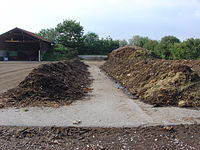
Photo from wikipedia
Although composting techniques are continuously optimised and adjusted, the removal of bacterial pathogen based on the quality of composting products needs further to ensure safe of agricultural use. In this… Click to show full abstract
Although composting techniques are continuously optimised and adjusted, the removal of bacterial pathogen based on the quality of composting products needs further to ensure safe of agricultural use. In this study, we combined aerobic composting and anaerobic process to determine the optimal combination (turning frequency of once a day, the proportion of swine manure to corn straw (3:1), and mixed 6-day anaerobic process) that benefits the reduction of bacterial pathogens, among which the maximum removal efficiency of up to 92.96% was observed for Clostridium_sensu_stricto_1 reached, thereby improving the quality of the compost products. The variation partition analysis and redundancy analysis indicated that physicochemical factors such as temperature, TOC, and pH significantly affected the removal of bacterial pathogens. Therefore, the additive effects of physicochemical factors on bacterial pathogen removal requires further process optimisation. These findings offer powerful technological support for improving agricultural waste recycling and enhancing the safety of fertiliser application.
Journal Title: Journal of environmental management
Year Published: 2021
Link to full text (if available)
Share on Social Media: Sign Up to like & get
recommendations!